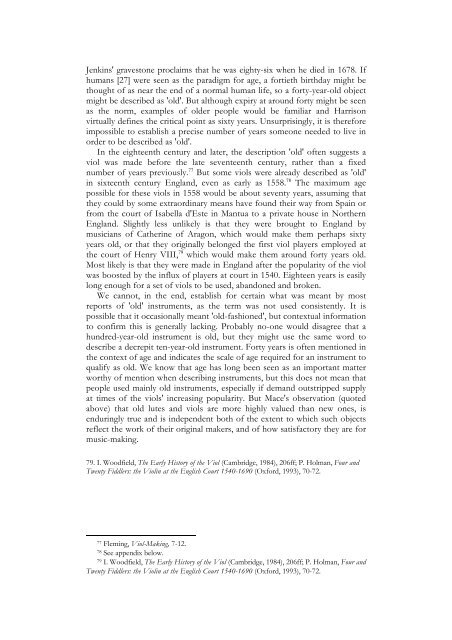download.pdf - 1.2Mb - Viola da Gamba Society
download.pdf - 1.2Mb - Viola da Gamba Society
download.pdf - 1.2Mb - Viola da Gamba Society
Create successful ePaper yourself
Turn your PDF publications into a flip-book with our unique Google optimized e-Paper software.
Jenkins' gravestone proclaims that he was eighty-six when he died in 1678. If<br />
humans [27] were seen as the paradigm for age, a fortieth birth<strong>da</strong>y might be<br />
thought of as near the end of a normal human life, so a forty-year-old object<br />
might be described as 'old'. But although expiry at around forty might be seen<br />
as the norm, examples of older people would be familiar and Harrison<br />
virtually defines the critical point as sixty years. Unsurprisingly, it is therefore<br />
impossible to establish a precise number of years someone needed to live in<br />
order to be described as 'old'.<br />
In the eighteenth century and later, the description 'old' often suggests a<br />
viol was made before the late seventeenth century, rather than a fixed<br />
number of years previously. 77 But some viols were already described as 'old'<br />
in sixteenth century England, even as early as 1558. 78 The maximum age<br />
possible for these viols in 1558 would be about seventy years, assuming that<br />
they could by some extraordinary means have found their way from Spain or<br />
from the court of Isabella d'Este in Mantua to a private house in Northern<br />
England. Slightly less unlikely is that they were brought to England by<br />
musicians of Catherine of Aragon, which would make them perhaps sixty<br />
years old, or that they originally belonged the first viol players employed at<br />
the court of Henry VIII, 79 which would make them around forty years old.<br />
Most likely is that they were made in England after the popularity of the viol<br />
was boosted by the influx of players at court in 1540. Eighteen years is easily<br />
long enough for a set of viols to be used, abandoned and broken.<br />
We cannot, in the end, establish for certain what was meant by most<br />
reports of 'old' instruments, as the term was not used consistently. It is<br />
possible that it occasionally meant 'old-fashioned', but contextual information<br />
to confirm this is generally lacking. Probably no-one would disagree that a<br />
hundred-year-old instrument is old, but they might use the same word to<br />
describe a decrepit ten-year-old instrument. Forty years is often mentioned in<br />
the context of age and indicates the scale of age required for an instrument to<br />
qualify as old. We know that age has long been seen as an important matter<br />
worthy of mention when describing instruments, but this does not mean that<br />
people used mainly old instruments, especially if demand outstripped supply<br />
at times of the viols' increasing popularity. But Mace's observation (quoted<br />
above) that old lutes and viols are more highly valued than new ones, is<br />
enduringly true and is independent both of the extent to which such objects<br />
reflect the work of their original makers, and of how satisfactory they are for<br />
music-making.<br />
79. I. Woodfield, The Early History of the Viol (Cambridge, 1984), 206ff; P. Holman, Four and<br />
Twenty Fiddlers: the Violin at the English Court 1540-1690 (Oxford, 1993), 70-72.<br />
77 Fleming, Viol-Making, 7-12.<br />
78 See appendix below.<br />
79 I. Woodfield, The Early History of the Viol (Cambridge, 1984), 206ff; P. Holman, Four and<br />
Twenty Fiddlers: the Violin at the English Court 1540-1690 (Oxford, 1993), 70-72.
















